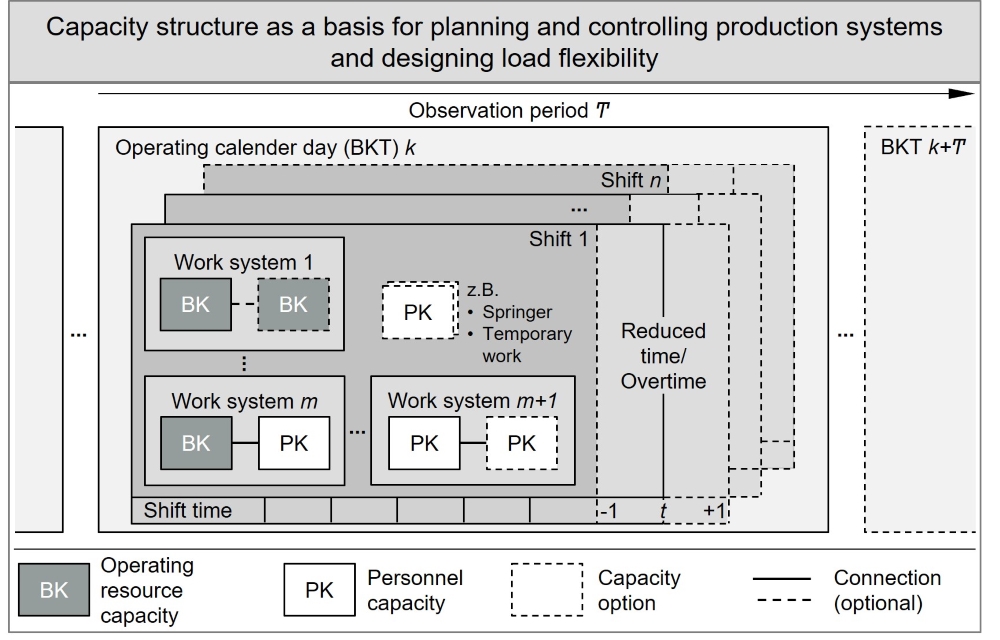Manufacturing companies, especially small and medium-sized enterprises (SMEs), are exposed to immensely volatile markets. In addition to increasing cost pressure and rising customer expectations for short-term availability of individual products, international competition intensifies volatility. This volatility can be observed both in overall demand and between product variants as variant mix fluctuations and equally leads to workload losses at the work systems in the production system and thus to high costs.
In order to meet customer expectations for individual products that can be delivered at short notice, it is essential for companies to develop continuously. High product quality, competitive prices, and delivery reliability and delivery time represent key purchasing criteria. Consequently, these factors are also target variables for planning and the design of production systems.
Scientists from the Institute of Production Systems and Logistics (IFA) at Leibniz University Hannover are working together with eight companies on the corresponding prerequisites, possible actions and effects of the operational design of the production system in the research project “Procedure for Operationalizing Load Flexibility for Handling Demand Fluctuations in Interlinked Work Systems of SMEs (GeProVar)”.
Influence of capacity structure on load flexibility
The goal is to obtain an operationalization of load flexibility and to provide a decision support tool for designing it for SMEs. For this purpose, the researchers pursue a systematic analysis of the prerequisites of the elements of the capacity structure. Likewise, the interdependencies of the measures are analyzed and taken into account.
An example of a capacity structure is an assembly station with one employee, a material buffer and a finished goods warehouse, which are interlinked and operate in a 2-shift system for eight hours per day per shift, five days a week. An extension of the capacity structure can be obtained in different ways depending on the given conditions – for example by overtime. Thus, the ability of load flexibility is already formed in the design of the elements of the capacity structure, and the ability to react in the short term is determined by a long-term design (see Figure 2: Capacity structure of a production system).
Development of a methodology to operationalize load flexibility
The basis of the methodology is the identification and description of general characteristics of products and their production processes. This enables a link to the elements of the capacity structure with effects on load variations, so that concrete indications for the design of load flexibility can be provided. A target-size-oriented catalog of measures for load matching forms the basis for developing possible scenarios and is intended to enable continuous expansion and individual adaptation. In order to be able to carry out a quantitative determination of the measure costs of these scenarios, an evaluation model is used. This will be deepened and extended from the previous research project, “GeProMe” (IGF project no.19021 N).
Furthermore, a mathematical optimization model for the cost-minimizing use of load flexibility will be modeled – taking into account the previously obtained results and restrictions. As an extended decision support for SMEs, various recommendations for action will be derived based on an individual evaluation of the scenarios. For this purpose, an implementation of the results into a software demonstrator will take place. The design of these points will be realized in close cooperation with the industry. Producing companies from plastics and glass processing, laboratory, process, medical and electrical engineering, as well as mechanical and plant engineering, are involved in this research project to ensure practical relevance and applicability.
Potentials of load flexibility
There is often a conflict of objectives between the performance of a production facility and on-time delivery – partly due to the increasing customer demand for individual products and the increasing volatility of the markets. Load flexibility offers significant potential to mitigate this trade-off between performance and on-time delivery. This research concept will be used to develop solutions for tapping these potentials. By exploiting this potential in production, both the economic efficiency in terms of cost savings and the logistical performance of manufacturing companies will be promoted. Thus the competitiveness in the global environment of enterprises and a constant adjustment to the ‘market’s requirements are secured.

